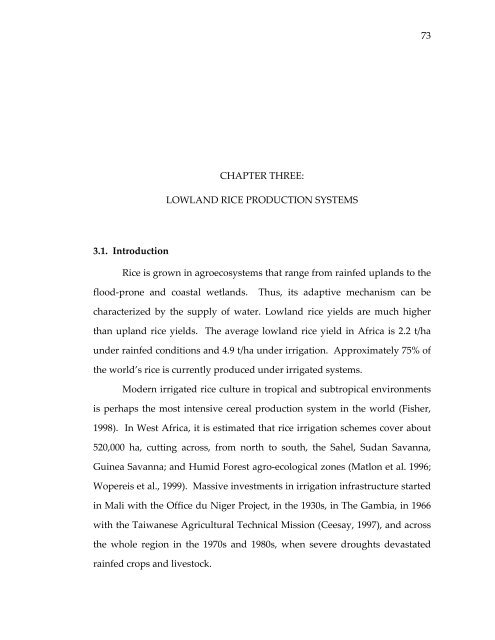Management of rice production systems to increase productivity
Management of rice production systems to increase productivity
Management of rice production systems to increase productivity
Create successful ePaper yourself
Turn your PDF publications into a flip-book with our unique Google optimized e-Paper software.
3.1. Introduction<br />
CHAPTER THREE:<br />
LOWLAND RICE PRODUCTION SYSTEMS<br />
Rice is grown in agroeco<strong>systems</strong> that range from rainfed uplands <strong>to</strong> the<br />
flood‐prone and coastal wetlands. Thus, its adaptive mechanism can be<br />
characterized by the supply <strong>of</strong> water. Lowland <strong>rice</strong> yields are much higher<br />
than upland <strong>rice</strong> yields. The average lowland <strong>rice</strong> yield in Africa is 2.2 t/ha<br />
under rainfed conditions and 4.9 t/ha under irrigation. Approximately 75% <strong>of</strong><br />
the world’s <strong>rice</strong> is currently produced under irrigated <strong>systems</strong>.<br />
Modern irrigated <strong>rice</strong> culture in tropical and subtropical environments<br />
is perhaps the most intensive cereal <strong>production</strong> system in the world (Fisher,<br />
1998). In West Africa, it is estimated that <strong>rice</strong> irrigation schemes cover about<br />
520,000 ha, cutting across, from north <strong>to</strong> south, the Sahel, Sudan Savanna,<br />
Guinea Savanna; and Humid Forest agro‐ecological zones (Matlon et al. 1996;<br />
Wopereis et al., 1999). Massive investments in irrigation infrastructure started<br />
in Mali with the Office du Niger Project, in the 1930s, in The Gambia, in 1966<br />
with the Taiwanese Agricultural Technical Mission (Ceesay, 1997), and across<br />
the whole region in the 1970s and 1980s, when severe droughts devastated<br />
rainfed crops and lives<strong>to</strong>ck.<br />
73
















